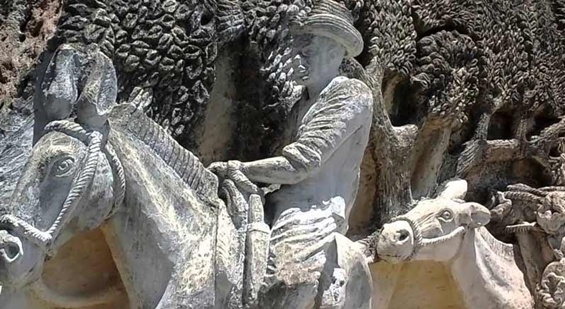History

Guantánamo is the easternmost province of Cuba, its name is of aboriginal origin, which means “Land between Rivers.” Fate would have it that this was where Christopher Columbus landed in 1492 and where the first town was founded, which was named Our Lady of the Assumption, in 1511.
On April 30, 1494, Christopher Columbus anchored his ships in Guantánamo Bay and named it Puerto Grande. In 1510, Diego Velásquez disembarked in one of its interior coves, which he named Puerto Palmas. From there the steps were taken to initiate the assault on what was to be one year later the first town founded on the island. All of which turned out to be the prelude to the conquest and colonization of Cuba.
For a long time, Guantánamo remained separated from the interests of the Spanish conquerors, despite the magnificent conditions of its bay and the fertility of its surrounding lands. In 1604, the Spanish bishop, Fray Juan de las Cabezas Altamirano, bought the hato of Ocaña, located between Guantánamo and Sagua de Tánamo, who put these lands towards producing. Most of these lands were acquired through usufruct of royal lands protected by the almost total depopulation of that region and the lack of interest shown by the colonial authorities. At the time, the region had a small population and a subsistence economy supported by the illegal trade with corsair ships and pirates.
On July 18, 1674, the English fleet of Admiral Edward Vernon stormed the bay to use it as a base of operations in the attack on Santiago de Cuba by land, that moment marked the beginning of the first scheme of a foreign power to try to conquer Cuba at the expense of Spain. Francisco Cajigal de la Vega, governor of the Oriental department organized the defensive actions against the English, who on July 28 had occupied the neighborhood of Tiguabo, which was abandoned after being burned by its inhabitants before it fell into enemy hands.
Six months later the English invaders were forced to sail away due to the resistance of the Guantanamo Creole guerrillas led by Pedro Guerra and Pedro Pérez, together with militiamen from Bayamo, Jiguaní, Holguín, Puerto Príncipe, Sancti Espíritus, Trinidad, Santiago de Cuba, and Havana. The English abandoned this campaign after having lost some 2,000 soldiers and officers from their forces.
Notes from the time show that in 1870 the town of Santa Catalina de Guantánamo arose after Franco-Haitian emigrants bought the hato of Santa Catalina, then a sparsely populated territory, but with fertile and mountainous lands, conducive to harvesting coffee, cotton, with this last crop later being replaced by sugar cane. They settled in El Saltadero, one of the slopes of the Guaso River, this site was used for the collection of fruits and productions from the hills, due to the navigable conditions for smaller boats.
Thus flourished the first urban center on the banks of the Guaso river, the main hub of commerce, where the Catalans had built their warehouses, advantageous not only for the port, but also for the passage from one side of the river to the other that made it possible to reach the surroundings areas that make up the “February 24th Park”, which had formerly been known as the Plaza of Isabel II.
Culture
Regarding the area’s cultural significance, it is important to recall that at the beginning of the republic Guantánamo was home to a true advertising fever with the founding of newspapers, weeklies, and magazines with the most dissimilar and heterogeneous ideological conceptions. Within this it was evident that the vanguard of the intellectual movement placed its knowledge within the reach of the popular masses to contribute to the development of culture in the region. Such is the case of the magazines Chic and Tauros, both founded in 1908 by Regino Eladio Boti, a nationally recognized poet, and Raúl Pullés, respectively.
With strong features in Cuban culture, it is unsurprising that this is where one of the forerunners of Cuban son emerged in Guantánamo, Baracoa, Manzanillo and Santiago de Cuba at the end of the 19th century. In 1892, the renowned Haitian-born Tres player Nene Manfúgas arrived from the mountains to the carnivals in Santiago de Cuba.
The province also has several indigenous musical rhythms of the territory such as the Nengón, the Changüí, the Kiribá, the Regina Montunera, the son Montuno and El Arioplano, it was in this region that the Cuban guitar of the son (El Tres) and the bongo drum came together.

The art is characterized by the folklore represented in the house of the Changüí, the French Tomb which is native to Haitian emigrants and various folk-dance groups such as the Fragmented Dance company, the Medulla dance group, Danza Libre, which was founded by the North American dancer Elfriede Mahler, Ballet Babul and the Jagüey group, from the University of Guantánamo.
The people of Guatanamo are distinguished by being supportive, humble, hospitable, loving, friendly, elegant in their way of dressing in a general sense, lovers of traditional festive activities, with a great sense of belonging to the Changüí rhythm as the genuine music of Guantanamo, and charismatic. They welcome visitors with a lot of warmth and stand out for being able conversationalists about both traditional and contemporary topics.
Places of interest
It has several important sites such as the Salcine Palace with the La Fama statue on its dome, the symbol of the province, the Stone Zoo Museum, the only one of its kind in the world, José Martí Park, one of the most spacious in the world, and at the same time unique of its kind due to its architectural design, the House Museum of the Major General of the liberating army Pedro Agustín Pérez, a national patriotic reference of the independence struggles, the Provincial Museum and the Hall of the Cosmonauts, and the old provincial prison, which is also unique in the country.
Like a Village, this is how the poet Regino E. Boti classified Guantanamo in his book “Mental Arabesques,” knowing full well that it has always been the province with the lowest level of economic development in the country, knowing that it has the worst housing stock and that it is the province, which is the least industrialized nationwide, knowing that the people in Guantanamo are the ones with the lowest quality of life in Cuba.
Much has been said, even on national television, that Guantánamo is the province with the most North American influence, understandably, since it is the province where the US naval base is located, and knowing that this land has been the protagonist of several armed uprisings by of its settlers, such as the uprising of the commune Realengo 18 to cite just one example among so many, since it seems that the government is making this territory pay with indifference and administrative abandonment, for all this northern influence and its tradition of rebellion.

Leave a comment